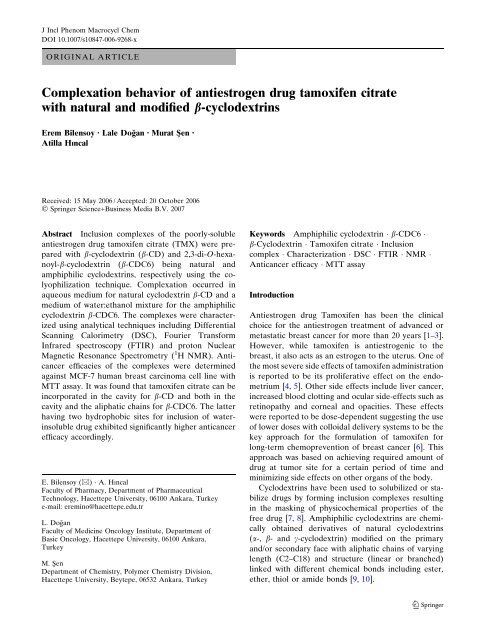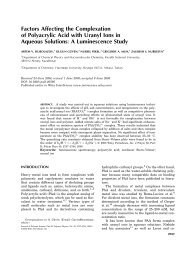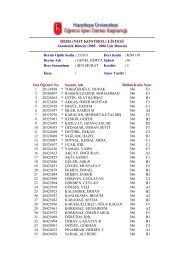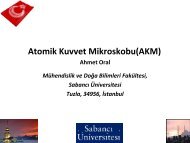Complexation behavior of antiestrogen.pdf
Complexation behavior of antiestrogen.pdf
Complexation behavior of antiestrogen.pdf
You also want an ePaper? Increase the reach of your titles
YUMPU automatically turns print PDFs into web optimized ePapers that Google loves.
J Incl Phenom Macrocycl Chem<br />
DOI 10.1007/s10847-006-9268-x<br />
ORIGINAL ARTICLE<br />
<strong>Complexation</strong> <strong>behavior</strong> <strong>of</strong> <strong>antiestrogen</strong> drug tamoxifen citrate<br />
with natural and modified b-cyclodextrins<br />
Erem Bilensoy Æ Lale Doğan Æ Murat S¸en Æ<br />
Atilla Hıncal<br />
Received: 15 May 2006 / Accepted: 20 October 2006<br />
Ó Springer Science+Business Media B.V. 2007<br />
Abstract Inclusion complexes <strong>of</strong> the poorly-soluble<br />
<strong>antiestrogen</strong> drug tamoxifen citrate (TMX) were prepared<br />
with b-cyclodextrin (b-CD) and 2,3-di-O-hexanoyl-b-cyclodextrin<br />
(b-CDC6) being natural and<br />
amphiphilic cyclodextrins, respectively using the colyophilization<br />
technique. <strong>Complexation</strong> occurred in<br />
aqueous medium for natural cyclodextrin b-CD and a<br />
medium <strong>of</strong> water:ethanol mixture for the amphiphilic<br />
cyclodextrin b-CDC6. The complexes were characterized<br />
using analytical techniques including Differential<br />
Scanning Calorimetry (DSC), Fourier Transform<br />
Infrared spectroscopy (FTIR) and proton Nuclear<br />
Magnetic Resonance Spectrometry ( 1 H NMR). Anticancer<br />
efficacies <strong>of</strong> the complexes were determined<br />
against MCF-7 human breast carcinoma cell line with<br />
MTT assay. It was found that tamoxifen citrate can be<br />
incorporated in the cavity for b-CD and both in the<br />
cavity and the aliphatic chains for b-CDC6. The latter<br />
having two hydrophobic sites for inclusion <strong>of</strong> waterinsoluble<br />
drug exhibited significantly higher anticancer<br />
efficacy accordingly.<br />
E. Bilensoy (&) A. Hıncal<br />
Faculty <strong>of</strong> Pharmacy, Department <strong>of</strong> Pharmaceutical<br />
Technology, Hacettepe University, 06100 Ankara, Turkey<br />
e-mail: eremino@hacettepe.edu.tr<br />
L. Doğan<br />
Faculty <strong>of</strong> Medicine Oncology Institute, Department <strong>of</strong><br />
Basic Oncology, Hacettepe University, 06100 Ankara,<br />
Turkey<br />
M. Şen<br />
Department <strong>of</strong> Chemistry, Polymer Chemistry Division,<br />
Hacettepe University, Beytepe, 06532 Ankara, Turkey<br />
Keywords Amphiphilic cyclodextrin b-CDC6 <br />
b-Cyclodextrin Tamoxifen citrate Inclusion<br />
complex Characterization DSC FTIR NMR <br />
Anticancer efficacy MTT assay<br />
Introduction<br />
Antiestrogen drug Tamoxifen has been the clinical<br />
choice for the <strong>antiestrogen</strong> treatment <strong>of</strong> advanced or<br />
metastatic breast cancer for more than 20 years [1–3].<br />
However, while tamoxifen is <strong>antiestrogen</strong>ic to the<br />
breast, it also acts as an estrogen to the uterus. One <strong>of</strong><br />
the most severe side effects <strong>of</strong> tamoxifen administration<br />
is reported to be its proliferative effect on the endometrium<br />
[4, 5]. Other side effects include liver cancer,<br />
increased blood clotting and ocular side-effects such as<br />
retinopathy and corneal and opacities. These effects<br />
were reported to be dose-dependent suggesting the use<br />
<strong>of</strong> lower doses with colloidal delivery systems to be the<br />
key approach for the formulation <strong>of</strong> tamoxifen for<br />
long-term chemoprevention <strong>of</strong> breast cancer [6]. This<br />
approach was based on achieving required amount <strong>of</strong><br />
drug at tumor site for a certain period <strong>of</strong> time and<br />
minimizing side effects on other organs <strong>of</strong> the body.<br />
Cyclodextrins have been used to solubilized or stabilize<br />
drugs by forming inclusion complexes resulting<br />
in the masking <strong>of</strong> physicochemical properties <strong>of</strong> the<br />
free drug [7, 8]. Amphiphilic cyclodextrins are chemically<br />
obtained derivatives <strong>of</strong> natural cyclodextrins<br />
(a-, b- and c-cyclodextrin) modified on the primary<br />
and/or secondary face with aliphatic chains <strong>of</strong> varying<br />
length (C2–C18) and structure (linear or branched)<br />
linked with different chemical bonds including ester,<br />
ether, thiol or amide bonds [9, 10].<br />
123
J Incl Phenom Macrocycl Chem<br />
In this study an approach based on the hypothesis <strong>of</strong><br />
localization <strong>of</strong> Tamoxifen citrate (TMX) in the target<br />
tissue with lower dose administration was used. To<br />
achieve this goal, TMX was complexed to natural<br />
cyclodextrin, b-cyclodextrin (b-CD) and modified,<br />
amphiphilic b-cyclodextrin, b-CDC6, to increase its<br />
limited aqueous solubility and to achieve similar anticancer<br />
efficacy with a lower dose <strong>of</strong> TMX incorporated<br />
in an inclusion complex with natural and/or amphiphilic<br />
b-cyclodextrins.<br />
Experimental<br />
Materials<br />
Tamoxifen citrate (TMX) was a kind gift from TEVA<br />
Pharmaceuticals (Plantex Netanya), Israel. Amphiphilic<br />
b-cyclodextrin, b-CDC6, modified on the secondary<br />
face with 6C aliphatic ester has been<br />
synthesized, purified and characterized as reported<br />
previously [11]. b-cyclodextrin (KleptoseÒ) was purchased<br />
from Roquette Freres, France. All organic<br />
solvents were <strong>of</strong> HPLC grade and were used without<br />
further purification.<br />
Preparation <strong>of</strong> inclusion complexes<br />
Inclusion complexes, TMX:b-CD and TMX:b-CDC6<br />
were prepared with 1:1 molar ratio using the modified<br />
co-lyophilization techniques to fit the physicochemical<br />
properties <strong>of</strong> b-CD and b-CDC6 [12].<br />
In this technique, briefly, TMX and b-CD were<br />
dispersed in deionized water and stirred to equilibrium<br />
for 5 days. Resulting suspension was filtered <strong>of</strong>f and<br />
the filtrate was lyophilized to achieve the TMX:b-CD<br />
in powder form. On the other hand, TMX and b-CDC6<br />
were both dissolved in absolute ethanol. Deionized<br />
water twice the volume <strong>of</strong> ethanol was added to form a<br />
dispersion which was stirred for equilibrium for 5 days<br />
followed by the evaporation <strong>of</strong> ethanol and lyophilization<br />
<strong>of</strong> aqueous disperson.<br />
Characterization <strong>of</strong> inclusion complexes<br />
Resulting inclusion complexes were characterized by<br />
techniques such as Fourier Transform Infrared (FTIR)<br />
spectrometry (Nicolet 520 FTIR spectrophotometer<br />
(Thermo Electron Corp, Waltham, MA)), Differential<br />
Scanning Calorimetry (DSC) (DuPont 910 differential<br />
scanning calorimeter (Wilmington, DE)) Proton NMR<br />
spectrometry ( 1 H NMR) (Bruker DPX 400 Digital FT-<br />
NMR Spectrophotometer, Germany) and Scanning<br />
Fig. 1 (A) DSC thermograms <strong>of</strong> TMX, b-CD and TMX:b-CD<br />
co-lyophilizate, (B) DSC thermograms <strong>of</strong> TMX, b-CDC6 and<br />
TMX:b-CDC6 co-lyophilizate<br />
Electron Microscopy (SEM) to demonstrate the formation<br />
and nature <strong>of</strong> inclusion complexes.<br />
Determination <strong>of</strong> anticancer efficacy <strong>of</strong> complexes<br />
Finally, the anticancer efficacy <strong>of</strong> TMX:b-CD and<br />
TMX:b-CDC6 complexes <strong>of</strong> 0.1 mg/mL each were<br />
compared using MCF-7 human breast cancer cell line<br />
(1,000 cells/well) with MTT assay to determine<br />
cell viability. MCF-7 cells were maintained in<br />
DMEM supplemented with 10% Fetal Calf Serum at<br />
37 °C in a humidified incubator containing 5% CO 2 .<br />
Confluent cell monolayers were trypsinized and cells in<br />
123
J Incl Phenom Macrocycl Chem<br />
Fig. 2 (a) FTIR spectra <strong>of</strong><br />
TMX, b-CD and TMX:b-CD<br />
co-lyophilizate, (b) FTIR<br />
spectra <strong>of</strong> TMX, b-CDC6 and<br />
TMX:b-CDC6 co-lyophilizate<br />
(a)<br />
(b)<br />
TMX<br />
TMX<br />
BCD<br />
BCDC6<br />
TMXBCD<br />
TMX:BCDC6<br />
4000<br />
3500<br />
3000<br />
2500<br />
2000<br />
1500<br />
1000<br />
500<br />
4000<br />
3500<br />
3000<br />
2500<br />
2000<br />
1500<br />
1000<br />
500<br />
Table 1 1 H NMR chemical shifts, d (ppm), <strong>of</strong> C–H protons <strong>of</strong><br />
b-CD and tamoxifen citrate:b-cyclodextrin complex taken in<br />
DMSO<br />
b-CD<br />
Complex<br />
H-1 4.82 4.81<br />
H-2 3.30 3.30<br />
H-3* 3.70 3.65<br />
H-4 3.20 3.20<br />
H-5* 3.65 3.55<br />
H-6a,b 3.75 3.75<br />
* Internal protons <strong>of</strong> cyclodextrin molecule that are expected to<br />
be affected by a potential inclusion complex formation<br />
exponentially growing phase were used in cytotoxicity<br />
experiments. The cytotoxicity <strong>of</strong> tamoxifen citrate<br />
complexes with b-CD and b-CDC6 against MCF-7 cells<br />
was assessed using MTT assay [13]. After 48 h incubation,<br />
20 lL MTT solution (5 mg/mL) was added to<br />
each well and the plates were incubated for further 2 h.<br />
The solution in each well containing media, unbound<br />
MTT and dead cells were removed by suction and<br />
100 ll <strong>of</strong> DMSO was added to each well. The plates<br />
were then shaken and the optical density (OD) was<br />
read on S960 ELISA reader at test wavelength <strong>of</strong><br />
570 nm. Cells incubated in culture medium alone<br />
served as a control for cell viability (untreated wells).<br />
Table 2 1 H NMR chemical shifts, d (ppm), <strong>of</strong> C–H protons <strong>of</strong><br />
b-CDC6 and tamoxifen citrate:b-CDC6 complex taken in DMSO<br />
Results and discussion<br />
b-CDC6<br />
Complex<br />
H-1 5.07 5.05<br />
H-2 4.75 4.75<br />
H-3* 5.30 5.05<br />
H-4 3.70 3.70<br />
H-5* 4.10 4.05<br />
H-6a,b 3.90 3.90<br />
* Internal protons <strong>of</strong> cyclodextrin molecule that are expected to<br />
be affected by a potential inclusion complex formation<br />
Various techniques were used in order to elucidate the<br />
structure and the formation <strong>of</strong> 1:1 inclusion complexes<br />
<strong>of</strong> tamoxifen citrate with natural cyclodextrin b-CD<br />
and amphiphilic cyclodextrin b-CDC6. Each technique<br />
confirms or completes the previous technique and the<br />
combined data obtained from these techniques add up<br />
to decide whether a total or partial inclusion complex is<br />
formed [14–16].<br />
In this context, thermal <strong>behavior</strong> <strong>of</strong> the drug in free<br />
form and in complex were determined by DSC analysis.<br />
Figure 1a, b displays the DSC thermograms <strong>of</strong> lyophilized<br />
123
J Incl Phenom Macrocycl Chem<br />
Fig. 3 SEM<br />
photomicrographs <strong>of</strong> b-CD,<br />
b-CDC6, TMX and the<br />
co-lyophilizates<br />
TMX, cyclodextrin and the co-lyophilizate for TMX:b-<br />
CD and TMX:b-CDC6, respectively. Thermograms<br />
indicate the absence <strong>of</strong> free crystalline TMX due to the<br />
disappearance <strong>of</strong> typical TMX melting endotherm at<br />
149 °C. DSC thermogram <strong>of</strong> TMX was taken after<br />
lyophilization <strong>of</strong> the drug in order to avoid alterations in<br />
the crystalline structure to amorphous state during the<br />
lyophilization process. FTIR spectra <strong>of</strong> the co-lyophilizate<br />
also indicated the disappearance <strong>of</strong> typical bands <strong>of</strong><br />
tamoxifen citrate such as tertiary amine bands at 900–<br />
1100 cm –1 , C=C stretching peaks at 1600–1700 cm –1 and –<br />
COOH band at 3000 cm –1 . This indicates that the drug’s<br />
chemical properties are masked due to inclusion in CD<br />
cavity for both natural and amphiphilic cyclodextrins.<br />
Corresponding FTIR spectra are seen in Fig. 2a, b. H<br />
NMR spectra taken at 400 MHz indicate signal shifts<br />
in the internal protons <strong>of</strong> the cavity H-3 and H-5 with<br />
shifts for H-3 being more significant for b-CDC6 compared<br />
to b-CD. Chemical shifts in proton signals for b-CD<br />
complex and b-CDC6 complex <strong>of</strong> tamoxifen citrate,<br />
respectively are given in Tables 1 and 2. Finally,SEM<br />
photomicrographs given in Fig. 3a–e indicate that<br />
the crystalline structures <strong>of</strong> the co-lyophilizates are<br />
significantly different than the free drug and the<br />
cyclodextrins. This could be due to the co-lyophilization<br />
techniques that is used to prepare the complexes which is<br />
very similar to the spherical crystallization techniques<br />
used in the manufacturing <strong>of</strong> nanoparticles. Crystalline<br />
structures <strong>of</strong> the free drug and the cyclodextrins are<br />
changed after the co-lyophilization process with a completely<br />
new crystalline or amorphous structure for the<br />
complex [17].<br />
Anticancer efficacy <strong>of</strong> TMX:b-CDC6 was found to<br />
be significantly higher than the TMX:b-CD as shown in<br />
Fig. 4. This was attributed to the fact that b-CDC6<br />
possesses two hydrophobic zones that the drug may be<br />
density<br />
Optical<br />
1,4<br />
1,2<br />
1<br />
0,8<br />
0,6<br />
0,4<br />
0,2<br />
0<br />
incorporated within; the CD cavity and the long aliphatic<br />
chains [17]. b-CDC6 is aligned with 14 aliphatic<br />
chains <strong>of</strong> 6C length which provides an advantage for<br />
interaction with lipophilic molecules. Thus, it is believed<br />
that higher amount <strong>of</strong> TMX was believed to be<br />
entrapped in amphiphilic cyclodextrin; b-CDC6 when<br />
compared to natural cyclodextrin, b-CD leading to<br />
significantly higher anticancer efficacy against human<br />
breast carcinoma cell line MCF-7.<br />
Conclusion<br />
Control TMX:BCD TMX:BCDC6<br />
Tested Formulation (1/16 dilution)<br />
Fig. 4 Anticancer efficacy expressed by cell viability (OD) <strong>of</strong><br />
MCF-7 cells after administration <strong>of</strong> TMX:b-CD, TMX:b-CDC6<br />
and control (treated with PBS pH 7.4)<br />
Poorly-soluble <strong>antiestrogen</strong> drug tamoxifen used in the<br />
treatment <strong>of</strong> metastatic breast cancer can be complexed<br />
to both natural and amphiphilic b-cyclodextrins.<br />
<strong>Complexation</strong> to amphiphilic b-cyclodextrin seems to<br />
result in high anticancer efficacy for the drug. CD<br />
123
J Incl Phenom Macrocycl Chem<br />
complexation may be an alternative in the formulation<br />
development <strong>of</strong> tamoxifen to reduce severe side effects<br />
associated with dose.<br />
Acknowledgements Authors wish to thank TUBITAK-CNRS<br />
(SBAG-CNRS-3) project and Hacettepe University Research<br />
Fund (0202301005) for financial support.<br />
References<br />
1. O’Reagan, R.M., Jordan, V.C.: The evolution <strong>of</strong> tamoxifen<br />
therapy in breast cancer: selective oestrogen-receptor<br />
modulators and downregulators. Lancet Oncol. 3, 207–<br />
214(2002)<br />
2. Pappas, S.G., Jordan, V.C.: Chemoprevention <strong>of</strong> breast<br />
cancer: current and future prospects. Cancer Metastasis Rev.<br />
21, 311–321 (2002)<br />
3. Powles, T.J.: Anti-oestrogenic chemoprevention <strong>of</strong> breast<br />
cancer- the need to progress. Eur. J. Cancer 39, 572–579<br />
(2003)<br />
4. Peters-Engl, C., Frank, W., Danmayr, E., Friedl, H.P., Leodolter,<br />
S., Medl, M.: Association between endometrial<br />
cancer and tamoxifen treatment <strong>of</strong> breast cancer. Breast<br />
Cancer Res. Treat. 54, 255–260 (1999)<br />
5. Cohen, I.: Endometrial pathologies associated with postmenopausal<br />
tamoxifen treatment. Gynecol. Oncol. 94, 256–<br />
266 (2004)<br />
6. de Lima, G.R., Facina, G., Shida, J.Y., Chein, M.B.C.,<br />
Tanaka, P., Dardes, R.C., Jordan, V.C., Gebrim, L.H.: Effects<br />
<strong>of</strong> low dose tamoxifen on normal breast tissue from<br />
premenopausal women. Eur. J. Cancer 39, 891–898 (2003)<br />
7. Albers, E., Müller, B.W.: Cyclodextrin derivatives in pharmaceuticals.<br />
CRC Crit. Rev. Ther. Drug Carrier Syst. 12(4),<br />
311–337 (1995)<br />
8. L<strong>of</strong>tsson, T., Masson, M., Brewster, M.E.: Self-association <strong>of</strong><br />
cyclodextrins and cyclodextrin complexes. J. Pharm. Sci.<br />
93(5), 1091–1099 (2004)<br />
9. Duchene, D., Ponchel, G., Wouessidjewe, D.: Cyclodextrins<br />
in targeting. Applications to nanoparticles. Adv. Drug Deliv.<br />
Rev. 36, 29–40 (1999)<br />
10. Memisoglu, E., Bochot, A., Şen, M., Özalp, M., Duchene, D.,<br />
Hıncal, A.A.: Direct formation <strong>of</strong> nanospheres from<br />
amphiphilic b-cyclodextrin inclusion complexes. J. Pharm.<br />
Res. 20(1), 117–125 (2003)<br />
11. Memisoglu, E., Bochot, A., Şen, M., Charon, D., Duchene, D.,<br />
Hıncal, A.A.: Amphiphilic b -cyclodextrins modified on<br />
the primary face: synthesis, characterization and evaluation<br />
<strong>of</strong> their potential as novel excipients in the preparation <strong>of</strong><br />
nanocapsules. J. Pharm. Sci. 91(5), 1214–1224 (2002).<br />
12. Hedges, A.R.: Industrial applications <strong>of</strong> cyclodextrins.<br />
Chem. Rev. 98, 2035–2044 (1998).<br />
13. Yang, X.H., Sladek, T.L., Liu, X., Butler, B.R., Froelich,<br />
C.J., Thor, A.D.: Reconstitution<strong>of</strong> caspase 3 sensitizes MCF-<br />
7 breast cancer cells to doxorubicin- and etoposide-inducedapoptosis.<br />
Cancer Res. 61, 348–354 (2001)<br />
14. Hedges, A.R., Shieh, W.J.: <strong>Complexation</strong> in modified<br />
cyclodextrins compared with unmodified cyclodextrins. In:<br />
Duchene, D. (ed.) New Trends in Cyclodextrins and Derivatives.<br />
Editions de Santé, Paris (1991)<br />
15. Schneider, H.J., Hackle, F., Rudiger, V.: NMR studies <strong>of</strong><br />
cyclodextrins and cyclodextrin complexes. Chem. Rev. 98,<br />
1755–1785 (1998).<br />
16. Thompson, D.O.: Cyclodextrins as enabling excipients: their<br />
present and future use in pharmaceuticals. CRC Crit. Rev.<br />
Ther. Drug Carrier Syst. 14(1), 1–104 (1997).<br />
17. Memisoglu-Bilensoy, E., Bochot, A., Trichard, L., Duchene, D.,<br />
Hıncal, A.A.: Amphiphilic cyclodextrins and microencapsulation.<br />
In: Benita, S. (ed.) Microencapsulation-2nd and Revised<br />
Edition, pp. 269–295, Taylor & Francis Ltd, New York, (2003)<br />
123








